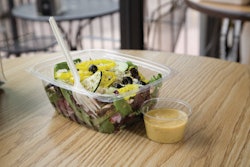Quick hits:
- Unilever’s Degree Inclusive pack prototype is intended to be accessible to people with limb and vision disabilities that render typical pack designs inaccessible.
- The pack will be durable and refillable, so even though it will likely be comparatively more expensive than existing packs, those costs amortize over time.
- As a durable package that won’t be quickly thrown away, the durable polyurethane structure is meant to last for months or years for cycle after cycle, where typical packs would be thrown away.
Related to this episode:
- People with limb, vision disabilities gain access with inclusive deodorant pack design
- Packaging is no spectator to the social moment
- Learn about Pack Expo Las Vegas' 2021 Reusable Packaging Pavilion and register for the show today.
- Learn how to avoid unplanned downtime by downloading PMMI's Packaging and Predictive Maintenance white paper for free.
 | Read the transcript below: |
Hi, I'm Matt Reynolds, editor of Packaging World Magazine, back with another Take Five. We get a lot of new product announcements that come in via email and, for the most part, these are products that are already hitting store shelves that we can find somewhere—whether it's Target or other retailer—and actually look at the product, look at the package that it's in, and thereby be able to report accurately on the material, the specs, and the size and whatnot.
I got one recently, just a couple of weeks ago, that I'm going to break the rules for a bit and actually talk about a prototype that is not out there in the wild yet, it's not a commercialized project, but it's far enough along that I think it will be making a splash before too long. And that's a project by Unilever and the brand is Degree Deodorant.
And first a little background. We've spent a lot of time lately on this Take Five platform and also in print, talking about how brands are being asked to step up to the plate in this socio-environmental moment and have a values-based stance that's being communicated to the consumer. And that's really in two different elements. One of them is sustainability and environmentalism and the other one is more on the social justice and social value/inclusion side.
So, what's packaging's role in these two kind of parallel trends? For the sustainability side, it's fundamental. Packaging is fundamental to the sustainability equation. What materials is it made from? What its carbon footprint? Is it made from post-consumer recycled materials? Is it recyclable? All of that is intrinsic to the package itself. But for the social justice and inclusion side, a lot of that has been limited to the text, the messaging, and the images that can be placed on the package so the package is more of a billboard or a way to reflect a company's values. However, this Unilever product, the package itself is the inclusion, the package itself is the access.
So an interesting pack design, as you can see, but it's still a prototype. We don't know everything about it yet. What do we know? We know that it's got a hooked cap design so that it can be hung in the shower setting, it's got a magnetic closure to make it easy to take the cap off and put it back on even while it's hanging, it's got an enhanced grip placement with an integral handle underneath for easy one-handed usage, a braille label for vision impaired, and a larger than usual roll-on applicator. So a lot of unique elements to the pack.
But what can detractors say? I suppose a real cynic could say, "Well, a package using magnets is going to be really expensive and that probably works against the philosophy of inclusion behind the package." And a cynic might also say that, "a polyurethane durable pack like that is not very easily recyclable." Well, I think Unilever will have easy answers to both of those critiques in saying that, first of all, amortizing the price over many different cycles, and also amortizing the material over many different cycles will actually bring down the cost per use and also the overall sustainability profile will be more favorable than if it were just used once and thrown away.
So indeed this is going to be a refill, durable container. We don't know what the refill packs look like yet, it could be in-store, it could be mailed to users on a subscription basis. Unilever, I'm sure, and Degree will be out with that information soon enough.
So where does a pack like this fit into larger trends? Well, it fits in with the durable packaging revolution that's happening right now. We're following the Loop platform closely. There's quite a few other personal care and cleaning products that are now available in durable packages that are then just refilled with cleanser that might be concentrated so as to avoid shipping water. Also, it's going to be on display at PACK EXPO Las Vegas so keep an eye out for that, that's going to be the reusable packaging pavilion. That's all the time that we have for this Take Five.


























